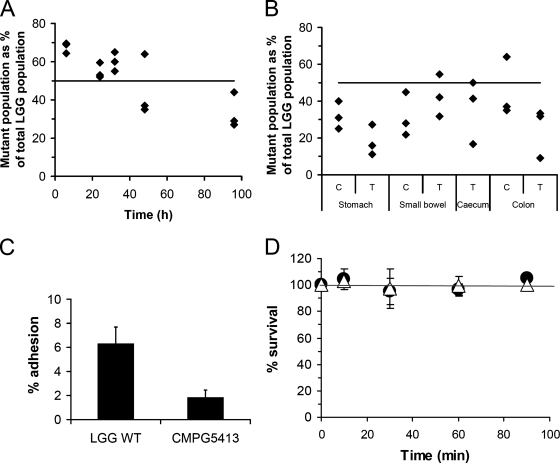FIG. 3.
Characterization of the GIT survival capacity of suppressor mutant strain CMPG5413. (A) Comparison of the wild-type control versus CMPG5413 for recovery in fecal samples. Mixtures of the wild-type control (LGG-Rifr) and mutant strain CMPG5413-Rifr (1:1) were administrated to three mice, and the percentage of mutants in the total L. rhamnosus GG (LGG) population was determined in fecal pellets at different time points. Values for individual mice are shown. The line indicates the initial ratio of 50% mutant to 50% wild type (1:1) of the total L. rhamnosus GG population administered to the mice. (B) Comparison of wild-type control versus CMPG5413 for adhesion to different tissue samples. Tissue (T) and content (C) samples were collected from three mice 48 h after gavage. The percentage of mutants recovered is indicated, compared to an initial ratio of 50% of the total L. rhamnosus GG population (line) upon administration. Values for individual mice are shown. (C) Comparison of the wild type versus CMPG5413 for adhesion to Caco-2 cells. Wild-type (WT) L. rhamnosus GG and mutant strain CMPG5413 were grown overnight until stationary phase. The adherence percentage is a measure of the ratio of the number of bacteria after adhesion to the initial number of bacteria added to the Caco-2 cells (ca. 109 CFU/ml). Each experiment was repeated at least three times, and error bars indicate standard deviations. (D) Comparison of the wild type versus CMPG5413 for survival in simulated gastric juice. The number of viable cells in simulated gastric juice was determined by plating a dilution series at different time points and expressed as a percentage of the initial numbers of cells added; circles indicate the wild type, and triangles indicate mutant strain CMPG5413. Data are the means of triplicate experiments, and error bars indicate standard deviations.

